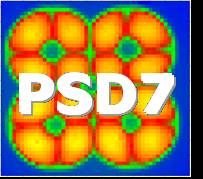Speaker
Mr
Dale Philips
(Monash University, Australia)
Description
The Monash Centre for Synchrotron Science (MCSS) Instrumentation
Group is working on various detector designs for biomedical imaging
and synchrotron use. The development of orthogonal planar strip HPGe
detectors offers advantages of good energy and x,y,z-axis position
resolution of gamma ray interactions. The efficiency in terms of
photoelectron absorption type events is quite low however (~3%), but
could be greatly improved by tracking and including Compton
interactions through the detector. If successful a system such as a
small animal PET detector would have either better image resolution
or shorter acquisition time (lower radioisotope dose).
In order to optimise the detector design it is useful to simulate
the various stages from interaction, through to detection, and image
reconstruction. This will aid decision making on the cost/benefit
trade-offs of increasing electronics complexity versus better image
resolution. For example, using more strips in the design would
improve the (x, y) position resolution but require more high speed
data channels. Likewise increasing pre-amplifier bandwidth would
improve resolution in depth (z) of near-coincident interactions but
increase the noise. Each of these effects on final image quality
will be evaluated before starting construction.
Here the modules for each simulation stage are described, the first
two of which have been written in IDL. In the first module the
detector geometry is defined and the signals appearing on each strip
for a set of incident gamma rays are generated using the method-of-
images. A graphical interface allows the user to vary the detector’s
physical and electronics parameters and view the signal results, or
batch process an events file into a signal output file.
The second module implements the Pulse Shape Analysis (PSA)
algorithms to identify the charge collecting and spectator strip
signals. The PSA algorithm is first calibrated by fitting signature
waveforms to the current signals of charge collecting strips at a
grid of known locations. As well, the ratio of induced signals on
the adjacent spectator strips is stored for points across the strip
width. This aids the later separation of superimposed interactions
along the z-axis and improve the x,y-axis positioning to better than
one strip width. The aim is to capture as much detail about partial
gamma energy interactions as possible and determine the limits of
resolving separate interactions. While initially the PSA algorithms
are intended for modelling and off-line analysis, the second aim is
for the final algorithms to be robust and fast enough to use in a
real-time embedded system.
The resulting interaction positions and energies can then be used
for the image reconstruction stage, details of which are presented
in companion MCSS papers. Where there are multiple Compton
interactions the energy and position of the first, and position of
the second interactions are needed. This cycle is repeated for
different detector designs and some initial results will be
presented.
Primary author
Mr
Paul Smith
(Monash Centre for Synchrotron Science)
Co-author
Mr
Dale Philips
(Monash University, Australia)




